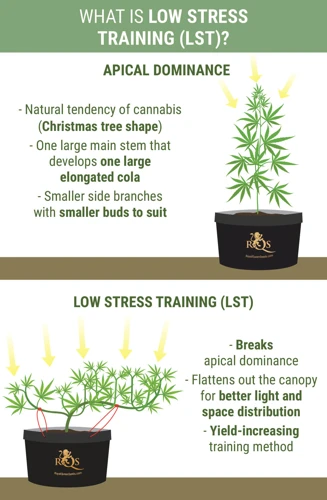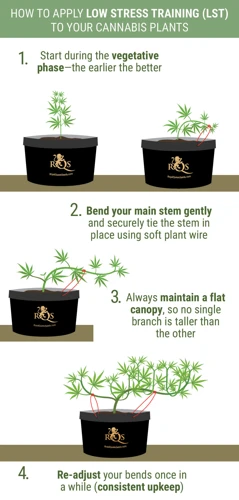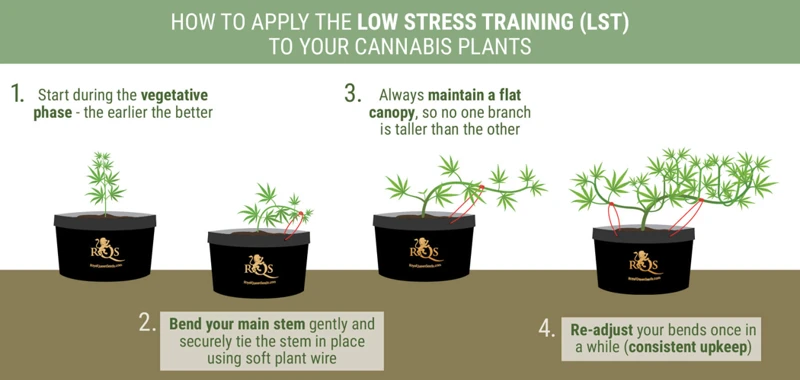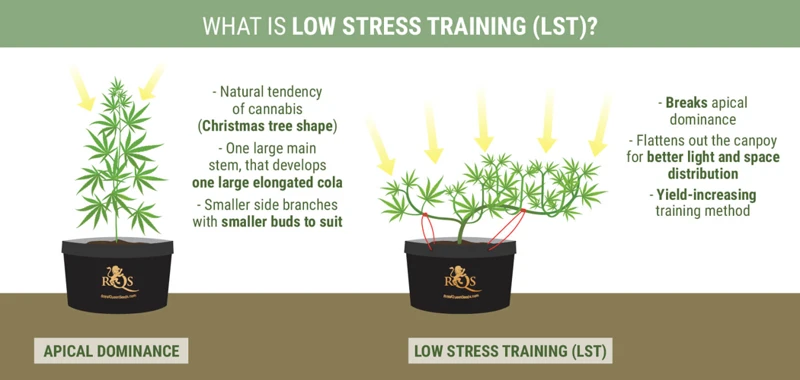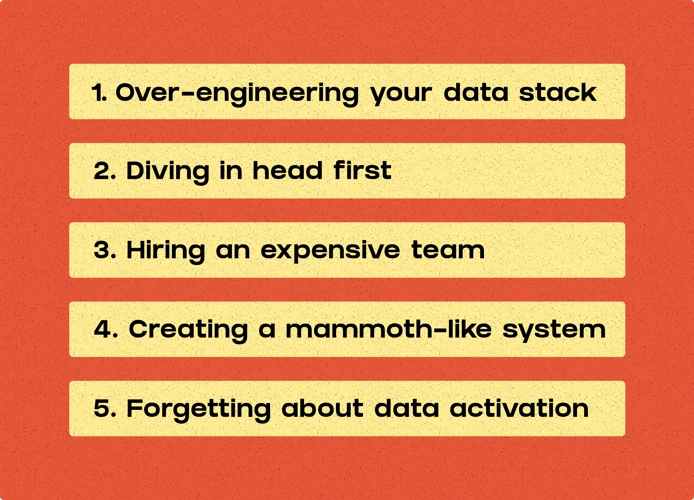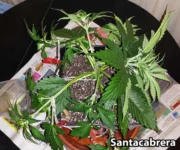
LST for Growing Cannabis: A Complete Guide
Growing cannabis requires a lot of attention and care. Every grower wants to maximize their yield and get the most out of their plants. But how can you do that without constantly buying new equipment and supplies? Low Stress Training (LST) – the answer to your worries. LST is a technique used by growers to manipulate the growth of their plants without causing them any harm. By using simple materials and techniques, you can coax your cannabis plants to grow bushier, with more buds and higher yields. In this article, we will cover the basics of LST and show you how to get started with this simple and effective technique.
What is LST?
Contents
Have you ever heard about bending and manipulating the stem of cannabis plants to control their growth and increase yields? This technique is called “Low Stress Training” or LST for short. LST involves gently bending the stems and securing them using different tools and materials to position the branches in a strategic way, allowing more light exposure and better nutrient distribution. By doing so, LST can significantly increase the number of bud sites and the overall size of the colas, resulting in a bountiful harvest. But how does LST work, and what are the tools and materials required? Let’s dive in and find out.
How Does It Work?
LST or Low Stress Training is a cannabis growing technique that involves gently bending and manipulating the plant’s stems to grow horizontally, instead of vertically. This technique has been growing in popularity over the years due to its ability to increase yields and maximize space.
LST works by utilizing the plant’s ability to respond to external stimuli. When the main stem’s tip is suppressed, the plant sends signals to its lower branches to grow more, resulting in more crop. The technique also helps the plant’s buds get more light and air, effectively allowing the plant to use its resources more efficiently.
In order to perform LST, one must have the proper tools and materials. These can include soft plant ties, stakes, and wire. When done correctly, LST can help cannabis growers achieve more desirable plant shapes, higher yields, and better overall quality.
Why is it Beneficial?
LST or Low Stress Training is highly beneficial for cannabis growers. Here are some of the reasons why:
- Promotes even canopy: By training the plant to grow horizontally, the canopy becomes more even resulting in more even distribution of light which leads to higher yields.
- Increases bud sites and yield: As the plant is trained to grow horizontally, it allows more light and air to reach the lower branches, promoting new bud sites and overall yield.
- Controls plant height: By bending and tying down the main stem, LST helps growers to keep the height of the plant under control, making it easier to manage and maintain.
- Improves airflow: As the plant is opened up, more airflow can circulate around the leaves, which in turn, helps to prevent mold and mildew from forming.
- Maximizes light absorption: By manipulating the plant’s growth, growers can ensure that all areas of the plant receive the same amount of light resulting in maximized light absorption and higher quality buds.
LST is a highly beneficial technique for cannabis growers that helps to promote even canopy, increase bud sites and yield, control plant height, improve airflow, and maximize light absorption.
Tools and Materials
Performing LST on cannabis plants requires specific tools and materials to ensure maximum benefit and success. Here are some of the essential tools and materials you will need to get started with LST:
1. Gardening gloves: It is crucial to have a pair of gardening gloves to protect your hand from possible injuries while performing LST.
2. Scissors or pruning shears: You will need a good pair of scissors or pruning shears to cut or trim branches as necessary.
3. Soft garden wire or ties: You will need some soft garden wire or ties to tie down branches during LST. These ties should be flexible enough to adjust as your plant grows.
4. Bamboo sticks or trellis netting: To support your plant during LST, you will need some bamboo sticks or trellis netting. These will help you to keep the branches secure and stop them from sagging.
5. LST clips or weights: LST clips or weights are optional materials that can be used to hold branches in place during LST.
6. Spray bottle: You will need a spray bottle to mist your plants and keep them hydrated during LST.
It is important to note that the quality of the tools and materials you use will make a significant difference in the success of your LST technique. Invest in good quality tools and materials to ensure maximum benefit and success.
How to Perform LST
For those looking to increase their cannabis yield, low-stress training (LST) is a popular and effective method that can help guide the growth of your plants. LST is a technique where the plant is gently bent and secured in a specific direction to encourage it to grow horizontally, which allows it to develop multiple colas (flowering sites) that receive more light, leading to bigger yields. In this section, we will explore the tools and materials needed to perform LST, as well as step-by-step instructions and tips for success.
Step-by-Step Instructions
Performing LST on your cannabis plants is a relatively easy process, but it requires some preparation and patience. Here are the step-by-step instructions to follow:
- Prepare your materials: Before you start, you will need some tools such as garden ties, stakes, or wire. Make sure you have everything you need ready to go.
- Choose your plant: Select the healthiest and strongest of your cannabis plants. Typically, younger plants with more pliable stems respond best to LST.
- Identify the node: Determine where the node is located, which is where the branches stem out from the main stalk. You will be bending this area.
- Bend the branch: Using your fingers, gently bend the stem downwards towards the soil. Be cautious not to snap the stem, as this can harm your plant. Secure the branch in place using ties or stakes.
- Repeat: LST works best when you apply it to several different nodes. Space the bends out evenly and create a canopy with as many branches as possible. This will help optimize the growth of your plant.
- Monitor: Give your plant a day or two to adjust to its new shape. Keep an eye on your plant to make sure it’s adapting and not experiencing any negative effects.
- Continue the process: As your plant grows, it will require more LST to maintain the shape you want. Follow the same steps to continue to bend and tie down new nodes.
- Harvest: Once your plant has matured, remove the ties or stakes and allow it to flower freely. This will enable your plant to grow to its full potential and produce a bigger yield.
Following these simple steps will allow your plants to grow horizontally, receive more light and develop a larger yield. Make sure to take your time and be gentle with your plants, and you should see significant results with LST.
Tips for Success
To ensure successful LST, there are some tips to keep in mind. Here are some of the most important ones:
| Tip | Explanation |
| Start early | It’s easier to manipulate the plant while it’s still young, so begin LST as soon as your plant develops a few internodes. |
| Use soft ties | Use soft materials, like plant-safe ties or twist-ties covered in soft material, to avoid damaging the plant. |
| Be gentle | Handle the plant gently when bending it. Slow and steady movements will prevent breaking or damaging the plant. |
| Avoid stressing the plant | While the goal of LST is to stress the plant to produce more buds, too much stress can actually stunt growth and negatively impact yield. Be careful not to over-stress the plant. |
| Keep an eye on growth | Check your plant’s growth regularly to make sure it’s responding well to LST. If you notice any damage or a lack of growth, adjust your technique or stop LST entirely. |
| Consider topping or pruning | Combining LST with topping or pruning can lead to even better results, allowing more light to reach lower branches and encouraging bushier growth. |
By following these tips, you can help ensure that your LST is successful and your cannabis plant produces a healthy, bountiful yield of buds.
When to Perform LST
Performing LST at the right time is crucial for maximizing its effects on the cannabis plants. As a general rule of thumb, LST should be started when the plant has 3 to 4 nodes, or when it is about 3 to 4 weeks old. This is because at this stage, the plant is still flexible enough and can be trained without causing too much stress.
However, it is also important to consider the growth stage of the plant when performing LST. LST should not be done during the flowering phase as it may cause significant stress to the plant, impacting its ability to produce buds. Additionally, LST should be done during the vegetative phase, as this is when the plant is actively growing and can adapt to the training.
Another factor to consider is the strain of the cannabis plant. Auto-flowering strains have a shorter vegetative period, so LST should be started earlier, around 2 to 3 weeks old, while for photoperiod strains, LST can be started at 3 to 4 weeks old.
It is also important to keep in mind the space available for the plant to grow. If you are growing in a limited area, LST should be performed earlier to prevent the plant from outgrowing its space. On the other hand, if you have ample space, you can perform LST later to allow the plant to grow bigger before training it.
In summary, LST should be performed during the vegetative phase, when the plant is about 3 to 4 weeks old and has 3 to 4 nodes, except for strains in the flowering phase. The timing of LST may differ for auto-flowering and photoperiod strains, and should also be considered in relation to the available space for the plant to grow.
Training Different Cannabis Strains
As a cannabis grower, it’s important to understand that different strains require different techniques for optimal growth and yield. This is especially true when it comes to training techniques like LST. Indica and sativa strains have different growth patterns and respond differently to LST, as do auto-flowering and photoperiod strains. Knowing these differences and how to tailor your LST techniques to your specific strain will help you achieve the best results possible. Let’s take a closer look at how to train different cannabis strains with LST.
Indica vs. Sativa
When it comes to LST, it’s important to understand the difference between Indica and Sativa strains of cannabis. Indica strains, which are often shorter and bushier, are better suited for LST as they have stronger stems and more lateral growth. Sativa strains, on the other hand, may not respond as well to LST as they tend to grow taller and have weaker stems.
In summary, Indica strains are generally easier to train with LST, while Sativa strains may require more careful attention and potentially different training techniques.
Auto-flowering vs. Photoperiod
Auto-flowering and photoperiod are two different types of cannabis strains, and they require different approaches when it comes to LST.
Auto-flowering strains are known for their short life cycle and fast growth. They switch from the vegetative stage to the flowering stage automatically, without requiring any specific light schedule. This means that the timing of LST for these strains is crucial, as any mistakes could negatively impact the yield. It is recommended to begin LST when the plant is young, at around two weeks old, and to be gentle with the bending process, as auto-flowering plants have a limited time to recover from any damage.
On the other hand, photoperiod strains require a change in light cycle in order to trigger the flowering stage. They typically have a longer vegetative stage, which provides more time for LST. However, it’s important to make sure not to begin LST too early, as the plant needs time to grow and establish itself before it can handle any bending. A good rule of thumb for photoperiod strains is to begin LST when the plant has reached at least four nodes.
| Auto-flowering | Photoperiod |
|---|---|
| Short life cycle | Longer vegetative stage |
| Switch from vegetative to flowering stage automatically | Requires a change in light cycle to trigger flowering stage |
| Timing of LST is crucial due to limited time for recovery | More time for LST, but should not begin too early |
| Begin LST at around two weeks old | Begin LST when the plant has reached at least four nodes |
In general, it’s important to research the specific strain you’re working with in order to determine the best approach for LST. This can help ensure that you’re not making any mistakes that could impact the overall health and yield of the plant.
Common Mistakes to Avoid
While low-stress training (LST) can significantly increase the yield and quality of your cannabis plants, there are common mistakes that can hinder your efforts. To get the most out of your LST, you should avoid the following mistakes:
Overbending: One of the most common mistakes in LST is over-bending the main stem. If you apply too much pressure, you can snap the stem, causing irreversible damage to the plant. To avoid this mistake, apply gentle pressure and bend the stem gradually over time.
Underbending: On the other hand, under-bending can also be a mistake. If you don’t apply enough pressure, you may not get the desired results from your LST efforts. To avoid this mistake, apply enough pressure to create a noticeable bend in the stem.
Improper Timing: Performing LST at the wrong time can cause more harm than good. For instance, if you wait too long to perform LST, the plant may have already developed woody stems that will not bend easily. Similarly, if you perform LST too early, the plant may not be strong enough to handle the stress. To avoid this mistake, perform LST during the plant’s vegetative stage when it’s young and flexible.
Wrong Knot Placement: The placement of the knots or ties is crucial in LST. If done correctly, they help keep the plant in place and promote horizontal growth. However, if you tie the plant too tightly or in the wrong place, you risk damaging the stems or restricting vital nutrient flow. To avoid this mistake, watch for any signs of constriction, make sure the ties are not too tight, and adjust them as necessary.
Overtraining: Overtraining your cannabis plants with LST can lead to stunted growth and reduced yields. While training your plants is beneficial, it’s essential to know when to stop. Overtraining can cause unnecessary stress on the plant, which can be counterproductive. To avoid this mistake, begin with gentle LST and gradually increase the force over time.
By avoiding these common mistakes, you can achieve the maximum benefits from LST and grow healthy, thriving cannabis plants.
FAQs
As you dive deeper into the world of LST, you’re bound to have questions about this innovative growing technique. That’s why we’ve compiled a list of some of the most frequently asked questions to give you a better understanding of LST and how it can benefit your cannabis plants. From timing to results, we’ll explore everything you need to know to get started with confidence. So, without further ado, let’s dive into the world of LST FAQs.
What is the Best Time for LST?
The Best Time for LST
Knowing the best time to perform LST on your cannabis plants is crucial for successful training. Generally, the ideal time to begin LST is during the vegetative stage, when the plant is still young and flexible.
During the vegetative stage, the plant is focused on growing and developing foliage, rather than producing buds. This makes it the perfect time to shape and train the plant to grow in a desired way. It’s recommended to begin LST when the plant is between 2-4 weeks old and has at least 4-6 nodes.
Performing LST during this stage allows for the plant to recover and adjust to the new shape before it begins flowering. It also allows for more time to train the plant before it becomes too woody and less flexible.
Starting LST too early, before the plant has developed enough nodes and leaves, can stunt its growth and overall yield. Conversely, starting too late, when the plant has already become too woody and rigid, can cause damage to the branches and strain the plant.
Below is a table summarizing the ideal interval for performing LST on cannabis plants:
| Stage | Age | Nodes |
|---|---|---|
| Seedling | 0-2 weeks | 1-3 nodes |
| Vegetative | 2-4 weeks | 4-6 nodes |
| Flowering | 4+ weeks | 6+ nodes |
Remember, timing is important for getting the most out of LST. Follow these guidelines and adjust based on the needs of your specific plant to achieve the best results.
How Long Does It Take to See Results?
Timing is an essential aspect of LST, and patience is key to achieving optimal results. When executed correctly, you can observe results within just a few days of performing LST. However, depending on the cannabis strain, it may take up to a week or two to see significant changes.
The rate of growth varies with each strain, and it also depends on the LST technique you choose. Below is a table that gives an estimated timeline for potential results using various LST methods:
| LST Methods | Estimated Timeline for Results |
|---|---|
| Bending and securing the main stem | A few days |
| Top and tie down | 1-2 weeks |
| Screen of Green (SCROG) | 3-4 weeks |
It’s important to remember that the results of LST are not always immediate, and you may need to make adjustments over time to achieve the desired shape and size for your plants. Be patient and monitor the progress regularly to ensure that your plant is developing properly.
If you feel that your plant is not responding to LST as you anticipated, reevaluate your technique and make changes accordingly. Remember, each plant is unique and may require different methods or a different timeline to achieve optimal results.
Can LST be Done on Plants in Flowering Stage?
Performing LST on Plants in Flowering Stage
One of the most common questions about LST is whether it can be performed on plants in the flowering stage. The short answer is yes, LST can be done on flowering cannabis plants, but there are some important considerations to keep in mind.
Pros and Cons of LST on Flowering Plants
Performing LST on flowering cannabis plants can be beneficial for a few reasons. First, it can help to increase yields by opening up more of the plant to light and encouraging the development of more bud sites. Second, it can help to create a more even canopy, which can lead to more consistent growth and better light penetration.
However, there are also some potential downsides to performing LST on flowering plants. For example, it can slow down the flowering process and delay harvest time. Additionally, if not done properly, LST in the flowering stage can cause damage to the plant and reduce yields.
How to Perform LST on Flowering Plants
If you decide to perform LST on a plant in the flowering stage, it’s important to be gentle and careful. Here are some steps you can follow to perform LST on a flowering cannabis plant:
| Step | Description |
|---|---|
| 1 | Select a branch to bend |
| 2 | Use soft ties to gently bend the branch, being careful not to break it |
| 3 | Secure the branch in place with stakes or ties |
| 4 | Monitor the plant for signs of stress or damage |
| 5 | Repeat the process with other branches as desired |
Important Considerations
There are a few important things to keep in mind when performing LST on flowering cannabis plants. First, be aware that the plant may be more fragile and delicate during the flowering stage, so be extra careful when bending branches. Second, try to perform LST early in the flowering stage to minimize the potential impact on yields and harvest time. Finally, monitor the plant closely for signs of stress or damage, and be prepared to adjust your approach if needed.
Conclusion
Performing LST on cannabis plants in the flowering stage can be a useful technique for increasing yields and creating a more even canopy. However, it’s important to be careful and gentle, and to monitor the plant closely for signs of stress or damage. By following these guidelines, you can safely and effectively perform LST on a flowering cannabis plant.
Conclusion
In conclusion, Low Stress Training (LST) is an effective technique used by many cannabis growers to increase yield and improve the overall health and strength of their plants. By bending and manipulating the branches, LST encourages the plant to grow more evenly and produce multiple colas, resulting in bigger harvests.
To perform LST, growers only need a few basic tools and materials like soft garden wire and plant ties. The technique can be done on different strains of cannabis, but it’s important to take into account the differences between indicas and sativas or auto-flowering and photoperiod strains.
While LST is a relatively simple technique, there are common mistakes that growers should avoid, such as over-manipulating the plant or not giving it enough time to recover between training sessions. By following the step-by-step instructions and tips for success, growers can expect to see results in as little as a few weeks.
In addition to the benefits of LST, such as increased yield and improved plant structure, this technique also allows growers to maximize their grow space and create more even canopies. However, it’s important for growers to keep in mind that LST is just one tool in their arsenal and should be used in conjunction with other best practices for growing healthy and productive cannabis plants.
Overall, if done correctly, LST can be a game-changer for cannabis growers who want to increase their yields without having to invest in expensive equipment or add more plants to their grow space. With patience and practice, growers can master the art of LST and take their cannabis growing to the next level.
Frequently Asked Questions
What is the purpose of LST?
The purpose of LST is to control the shape and height of cannabis plants to increase yield and optimize light distribution.
What materials are needed for LST?
For LST you will need plant ties or twine, stakes, and scissors or pruning shears.
What is the best time to start LST?
The best time to start LST is during the vegetative stage when the plant is still pliable and can be shaped without causing damage.
How long does it take to see results from LST?
You can begin to see results from LST in as little as a few days, but it can take up to a week or two to see substantial changes.
Can LST be done on plants in the flowering stage?
While it is possible to LST plants during the flowering stage, it is not recommended as it can cause damage to the delicate buds.
What is the difference between indica and sativa when it comes to LST?
Indica plants tend to be shorter and bushier, making them ideal candidates for LST. Sativa plants can be taller with larger inter-node spacing and require more careful training.
What is the difference between auto-flowering and photoperiod strains for LST?
Auto-flowering strains have a finite growing period that is not determined by light cycles, so LST should be started early and with caution. Photoperiod strains have a vegetative stage that can be extended, making them better for LST.
Can LST be performed on outdoor plants?
Yes, LST can be performed on outdoor plants as long as the conditions are right and the plants are in the vegetative stage.
What are some common mistakes to avoid when performing LST?
Common mistakes to avoid when performing LST include stressing the plant too much, not giving the plant enough time to recover between sessions, and not monitoring the plant for any signs of damage.
How often should I perform LST?
You can perform LST as often as you like during the vegetative stage, but it is important to give the plant enough time to recover between sessions.

